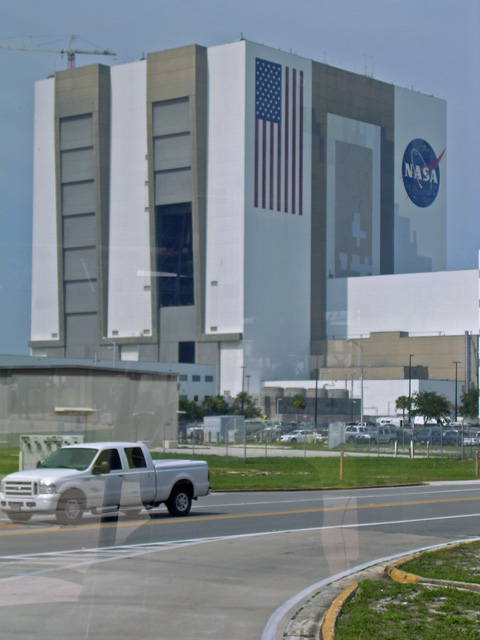
The Vehicle Assembly Building (VAB).
The VAB is where all manned
spaceflight rockets are assembled before launch. Originally
it was built to assemble the huge 36-story high Apollo
Saturn 5 rockets to go to the moon. It dominates the
entire Kennedy Space Center. When built, it was the largest
building by volume in the world (it's now 3rd). It's 52
stories tall, covers 8 acres of ground
and contains 129,428,000 cubic feet of space.
It has four bays and was designed to be able to assemble
four Saturn 5 rockets at
once. As tall as the building is, the lighting rod at the
top of the Saturn 5 had to be removed to get it out of the
building.
It's size is deceptive, it doesn't look as big as it is.
That's partly because of it's width, which makes the
building look shorter and smaller. In reality, it's
like four 52-story skyscrapers stuck together. One of the
stripes of the flag is wide enough for a full size
tour bus to drive on.
Follow these links to two design pictures,
here and
here. You can get the feel that
this was really futuristic stuff back in the early '60's
when they were designing it.
You can read more about the VAB
here. This link has a few pictures of the VAB
under construction.
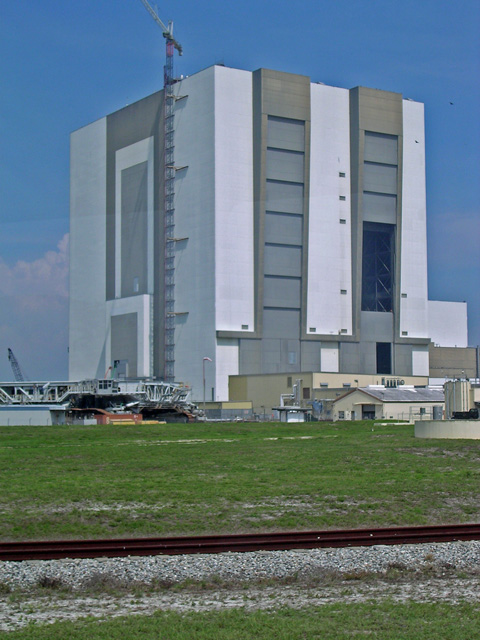
Over 40 years, the black painted trim of the gigantic
building has been faded to a light gray by the searing
Florida sun.
The crane is to help with repairs and modifications that
are still on going from damage caused by Hurricanes Charley
and Frances.
An upper corner of the VAB now serves as the resting
place of the crated remains of the Space Shuttle Columbia.
As the tour diver said with an emotional voice, "Columbia
finally retuned, and is now tucked away in the safety of
the Vehicle Assembly Building for all time". You could hear
the pain of the accident in his voice. It brought the
reality of the tragedy a little more home to me.
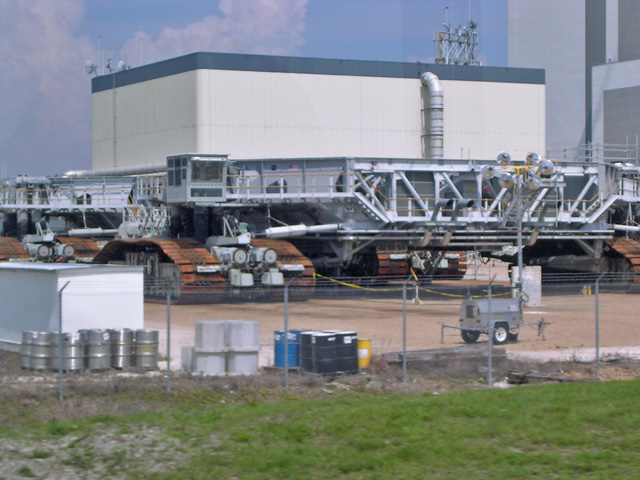
This is one of the crawlers that move the launch platform and spaceship
(first the Saturn 5 moon rocket and now the Space Shuttles)
out to the launch pad.
There are two crawlers, one named Hans, the other named
Franz.
These machines were once the largest tracked vehicles in the
world (now surpassed by a giant German excavator). Each one
of the shoes that make one of the tracks weighs 1 ton.
The crawler by itself weighs 6 million lbs. The
crawler drives under a launch platform and lifts it onto
it's back.
The Shuttle, External Tank, and Solid Rocket Boosters (SRBs)
are then all stacked (assembled) on top of the launch
platform. The crawler-transporter then balances the whole 11
million pound platform and Shuttle assembly on it's head and
drives out to the launch pad. The whole thing weighs
17 million pounds as it drives out to the pad. In the Apollo
days, it had to balance a 36-story Rocket and Launch Tower
as it moved down the crawler-way to the launch pad!
The crawler is powered by two 2,750-hourspower diesel
engines that power four 1000kW generators that then power
the 16 electric traction motors. Two 1,065-horsepower
engines power the hydraulics for leveling and steering, as
well as the lighting, and ventilating.
Here can read more and see more pictures of the crawlers
here,
here, and
here.
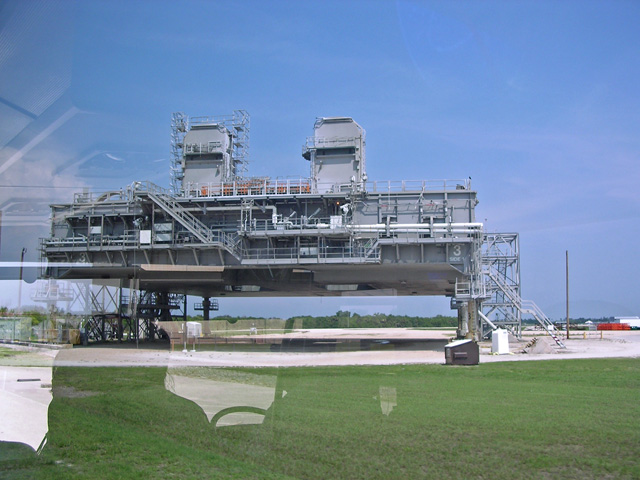
Here's a mobile launch platform. The platforms originally had a 380
foot tower structure on them to support the Saturn
5 moon rocket. The tower was removed and these wing
supports added to convert the platform for use by the Shuttle.
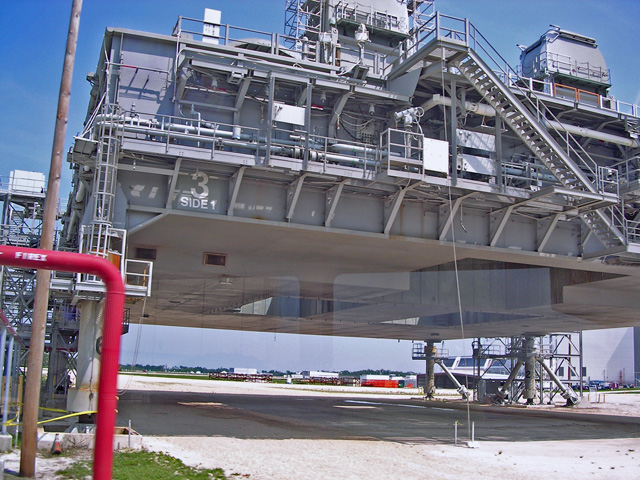
If you look in the middle of the underside of the platform,
you can see the openings where the blast jets from the Shuttle's
three main engines and the Sold Rocket Boosters comes
through the platform. Like everything else here this is much
larger than it looks.
The Crawler just drives in under the platform and lifts it up and onto
its back and takes it and whatever is on it where it needs
to go.
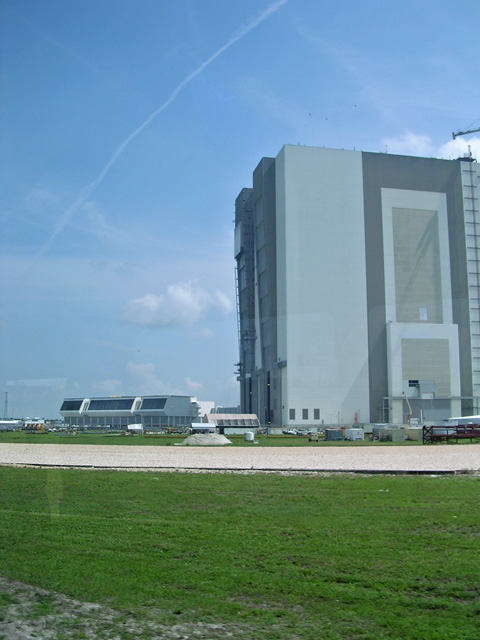
Beside and below the VAB is Launch Control.
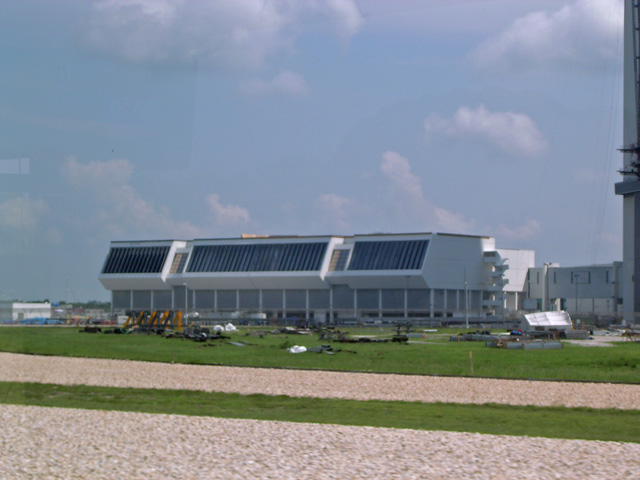
As you might guess, this is where the control room for
launch is located. The Shuttle launches are all
controlled from Firing Room 4. Tomorrow, 300 NASA and
contractor personnel will be in the Firing Room. This is
where all the checks and monitoring of the Shuttle happens.
The launch director and engineers are already there
checking on all the components of the Shuttle as it gets
ready to launch tomorrow.
You've probably heard the launch director on TV or in movies
like Apollo 13 as he
goes down the list and polls the status of each section.
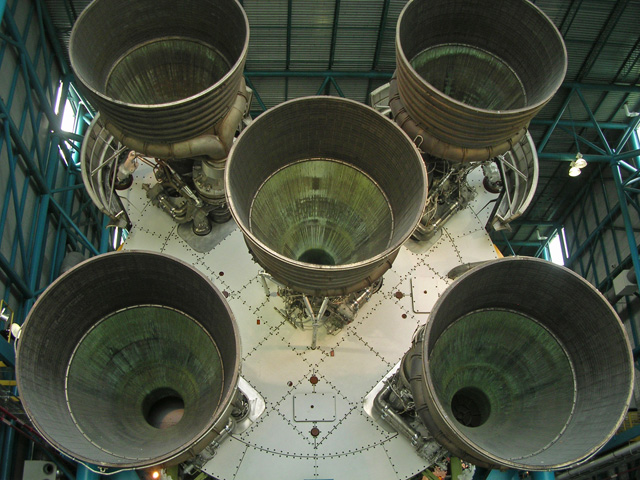
This is the business end of a Saturn 5 moon rocket. The Saturn 5
was the most powerful machine ever built by man. These five
F1 engines on the first stage generated 7.5 million
pounds of thrust. Easily enough power to lift the entire 36 story, 6.1
million pound rocket, from 0 to 6000 miles per hour in 2 1/2
minutes.
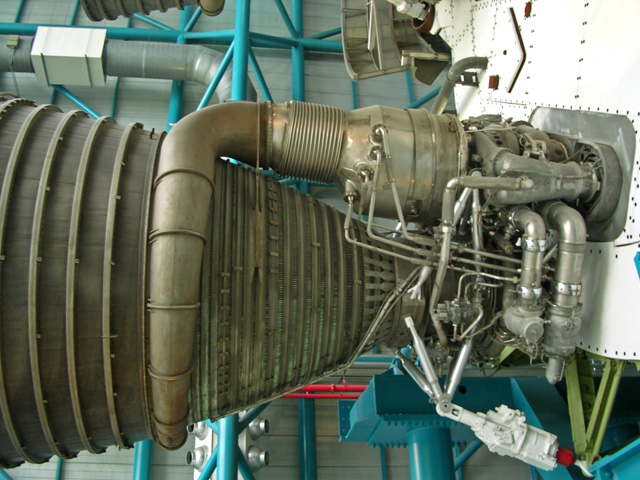
Each engine
generated 1.5 million pounds of thrust and is still the
worlds largest and most powerful single chamber liquid
fueled rocket engine. You can read more about them
here
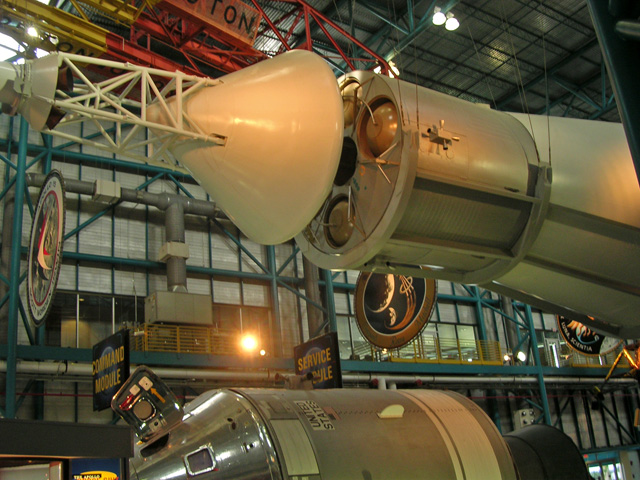
The "top" of the Saturn 5 at the other end of the building.
Here you can see the Service Module and Command Module both
attached to the Saturn 5 and separate as they were on their
way to the moon.
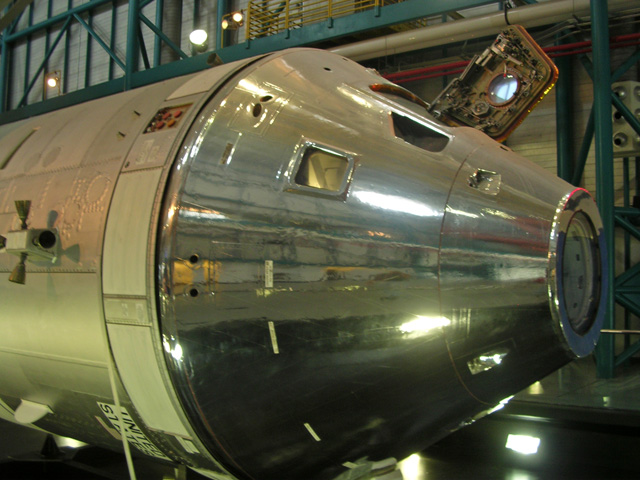
The silver part is the Command Module. The astronauts
rode in this capsule up into space and returned to earth in
it.
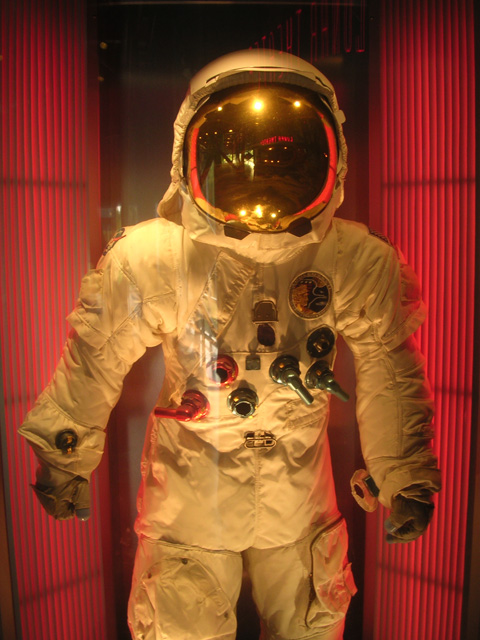
A real Apollo space suit.
There was also a real moon rock inside a sophisticated
display case that you could reach into and touch. So I did
get to touch a piece of the moon. As with a lot of the experiences
on the tour, I was so excited and overwhelmed that I
didn't think to take a picture. I was too busy taking it all
in.
From the Apollo/Saturn 5 Center,
the tour bus takes us on out to the LC39 Observation
Gantry. From there you can get a 360 degree view of the
entire complex from it's open forth floor. Sorry, but once
again I didn't think to take a picture of the whole gantry.
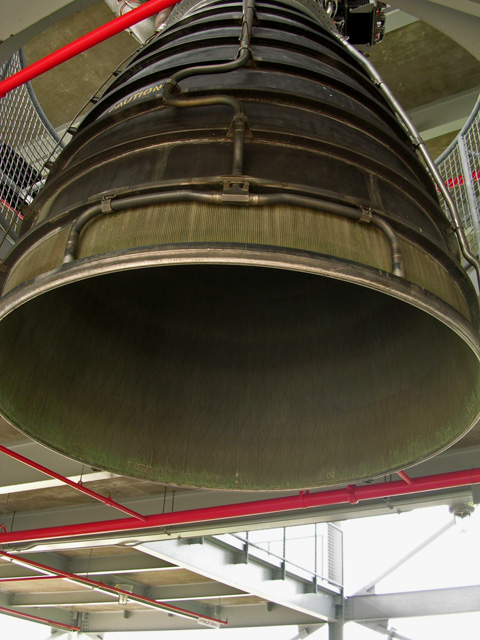
Hanging between floors in the gantry was a Space Shuttle Main
Engine (SSME) that actually helped push a Shuttle into orbit.
This is a lot bigger than it looks.
When the hydrogen is burned with liquid oxygen in the
combustion chamber, it reaches temperatures greater than 6000 degrees
Fahrenheit.
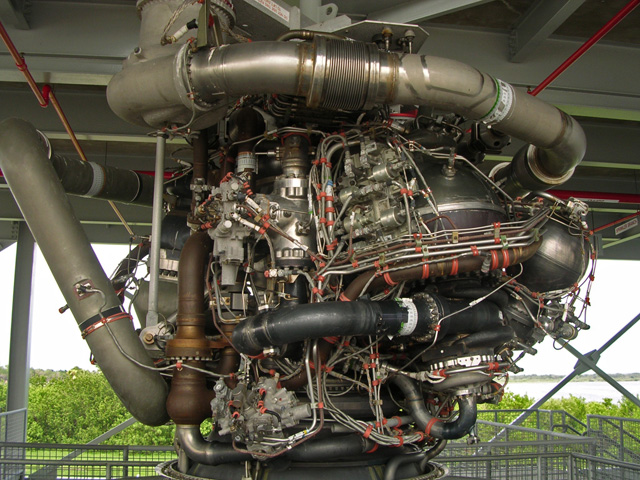
The pumps and valves where EXTREMELY complicated. This was
some of the most complicated and sophisticated machinery
possible in the 1970's and is still the most advanced
liquid-fuel rocket engine ever built. It has the highest
thrust to weight ratio of any rocket ever built and is the
most efficient at 99%. It weighs right at 7000 lbs and at sea
level, at max thrust, generates 488,000 lbs of thrust.
That's about 12,000,000 horsepower!
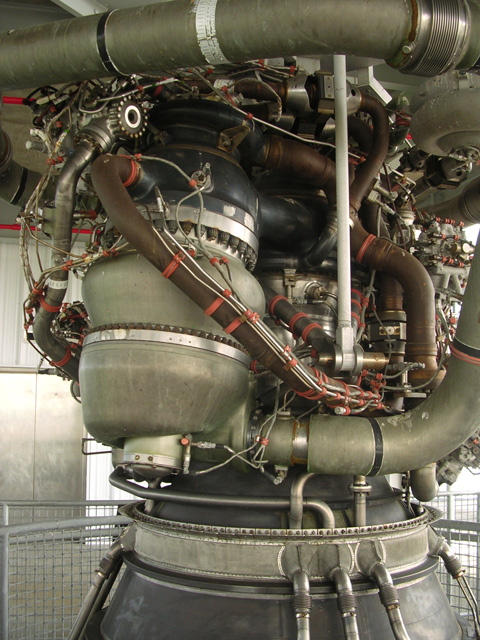
This fuel pump spins at 37,000 rpms and generates 69,000
horsepower on it own, about as much as 28 locomotives! If
the engine used water instead of liquid hydrogen and oxygen,
it would drain your average back yard swimming pool in 25
seconds. You can read more about SSMEs
here,
here,
and here
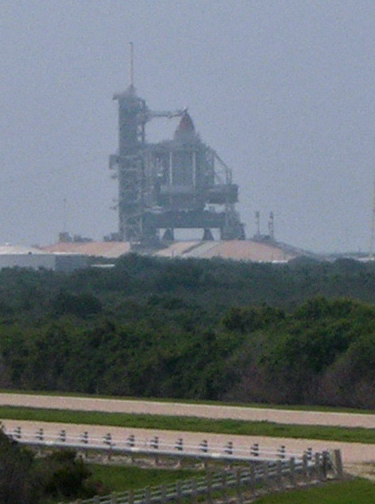
From the top of the gantry you could look out and see
Discovery setting there...The protective
Rotating Service Structure (RSS) is still around Discovery
as they perform last minute inspections. You can see the top of the external tank sticking out. The RSS will pivoted out of the way
in just a little while, leaving Discovery
exposed on the pad.
Since we
were the last at the gantry, Kenny and I had the whole place
to ourselves. Not a sole was there except the bus driver in
the bus. We were going to be last "civilians" to be this
close.
The sun is setting and a warm moist breeze is blowing in
off the shore. It was quiet, not a sound except the
call of the gulls overhead. I almost thought I could hear
the sounds of the surf on the beach.
As we stand there looking out at the ship, I get a real
sense of her.
Her size, her weight, her abilities. A real
space ship setting right there, waiting for the time in a
few hours when she will blast off in a blaze of fire to
sail above all the earth....
... a real spaceship right in front of me.
It was a very, very cool time. It was our own personal time with Discovery.
The ship became real....
Absolutely unforgettable.
Back to Trip to Kennedy Space
Center

 Tour of Kennedy Space Center, June 30, 2006
Tour of Kennedy Space Center, June 30, 2006















